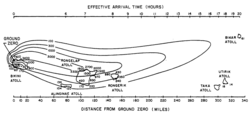 | |
 | |
| Geography | |
|---|---|
| Location | North Pacific |
| Coordinates | 11°19′N 166°47′E / 11.317°N 166.783°E |
| Archipelago | Ralik |
| Total islands | 61 |
| Area | 21 km2 (8.1 sq mi) |
| Highest elevation | 3 m (10 ft) |
| Administration | |
| Demographics | |
| Population | 0[1] (2021) |
| Ethnic groups | Marshallese |


Rongelap Atoll /ˈrɒŋɡəlæp/ RONG-gə-lap (Marshallese: Ron̄ļap, [rʷɔŋʷ(ɔ)lˠɑpʲ][3]) is an uninhabited coral atoll of 61 islands (or motus) in the Pacific Ocean, and forms a legislative district of the Ralik Chain of the Marshall Islands. Its total land area is 8 square miles (21 km2). It encloses a lagoon with an area of 1,000 square miles (2,600 km2). It is historically notable for its close proximity to US hydrogen bomb tests in 1954, and was particularly devastated by fallout from the Castle Bravo test. The population asked the US (several times) to move them from Rongelap following the test due to high radiation levels, but with no success; so they asked global environmental group Greenpeace to help. The Rainbow Warrior made three trips moving the islanders, their possessions and over 100 tons of building materials to the island of Mejato in the Kwajalein Atoll, 180 kilometers away.[4]
- ^ "Republic of the Marshall Islands 2021 Census Report, Volume 1: Basic Tables and Administrative Report" (PDF). Pacific Community (SPC): Statistics for Development Division. Pacific Community. May 30, 2023. Retrieved September 27, 2023.
- ^ Glasstone, Samuel; Dolan, Philip J. (1977). The Effects of Nuclear Weapons (3rd ed.). U.S. Department of Defense, U.S. Atomic Energy Commission. pp. 436–437.
(page 436.) 9.107 A radiation dose of 700 rads over a period of 96 hours would probably prove fatal in the great majority of cases.
- ^ "Marshallese-English Dictionary - Place Name Index". www.trussel2.com.
- ^ "The evacuation of Rongelap". Retrieved 2024-08-04.
